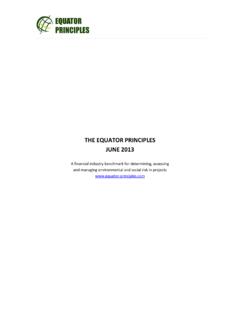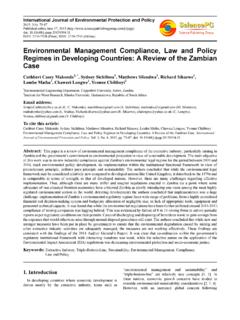Transcription of UGANDA’S OIL REFINERY – AN OPPORTUNITY FOR …
1 UGANDA S OIL REFINERY AN OPPORTUNITY FOR transformation Uganda s petroleum products consumption is at 27,000 barrels/day and that for East Africa is close to 200,000 barrels/day growing at an annual rate of about 7%. This fact presents an OPPORTUNITY to Uganda, with the confirmation of over billion barrels of recoverable oil in the country. Objective 4 of the National Oil and Gas Policy (2008) for Uganda is to promote valuable utilisation of the country s oil and gas resources through in-country refining of crude oil. In fulfillment of this objective, the Ministry of Energy and Mineral Development formulated a REFINERY Development Programme (RDP) to guide the development of a REFINERY in the country.
2 Uganda s RDP is in line with the East African Regional Refineries Development Strategy, adopted by the EAC Partner States in 2008 which recommended that a second REFINERY in East Africa be developed in Uganda. Subsequently, Government contracted Foster Wheeler Energy Limited Ltd from the United Kingdom to conduct a feasibility study on building a REFINERY in Uganda in 2010/2011. The feasibility study recommended that the development of 60,000 barrels per day REFINERY was commercially viable with a Net Present Value (NPV) of US$ billion at a 10% discount rate and an Internal Rate of Return (IRR) of 33%.
3 It also recommended the size and configuration of the REFINERY , location, financing options, social and environmental assessment, among others. Government plans to develop a REFINERY with an input capacity of 60,000 barrels per day in a modular manner, with the first phase in place by 2018. The enactment of the Petroleum (Refining, Conversion, Transmission and Midstream Storage) Act 2013 gives a firm legal foundation for this development together with other related infrastructure. The planned REFINERY will produce Liquefied Petroleum Gas (LPG), diesel, petrol, kerosene, jet fuel and Heavy Fuel Oil (HFO).
4 Location and Land Acquisition The feasibility study recommended Kabaale Parish in Buseruka Sub County, Hoima district as the most suitable location for the REFINERY . This is due to its centrality in relation to the entire Albertine Graben, proximity to the oil fields, sparse population and relatively low laying terrain among others. The Ministry is in the process of acquiring 29 of land for the REFINERY . This land will host staff quarters, a health facility, an International Airport, waste management facilities and petrochemical industries among others. A Resettlement Action Plan (RAP) to guide acquisition of the required land was undertaken during 2012.
5 The objective of the RAP was to develop a framework for managing the loss of economic activities and livelihoods through compensation and/ or relocation of the affected people. The RAP study was conducted between June and October 2012 after engagements with the district, local, cultural, and religious leaders together with the affected communities. It involved sensitization of affected communities about the project and available resettlement options, a socio-economic baseline study, cadastre survey of individual parcels of land and valuation of property.
6 The valuation report was approved by the Chief Government Valuer in December 2012. The compensation rates for crops and non-permanent structures are set by the District Land Boards and approved by the Chief Government Valuer in Ministry of Lands, Housing and Urban Development. The value for land is determined by professional valuers after conducting a survey to establish the prevailing market price for land in a given locality. These rates are also verified and approved by the Chief Government Valuer. Implementation of the RAP commenced in July 2013 with disclosure of compensation values to verified land, crop and property owners.
7 The disclosure was a transparent and voluntary process done in the presence of the Village RAP Committee and Local leaders. Affected persons are shown a detailed breakdown of their property including acreage of land and the monetary value. The PAPs were then trained in financial management and livelihood improvement to enable them put to good use the compensation packages. Payment of compensation packages commenced in December 2013 and resettlement areas/land has been identified for those that opted for resettlement. Construction of resettlement houses will commence after the said land has been paid for.
8 As this process is ongoing, sensitisation and engagements with the PAPs continues to ensure a smooth exercise. The process of RAP implementation has been largely successful due to the cooperation between the Ministry, Local Government leaders (technical, cultural, political) at all levels and the Communities with over 95% of the PAPs signing the compensation agreements. Any grievances are handled within the established frameworks and grievance handling mechanisms. This exercise is aligned to the existing laws and international guidelines such as the Equator Principles/IFC/World Bank operational guidelines and other safeguard policies on resettlement.
9 Financing the REFINERY Uganda contracted the services of a Transaction Advisor (TA), Taylor-DeJongh, an energy investments firm from USA. The TA is supporting Government in sourcing for the lead investor and financing for the REFINERY , which will be developed on a Public Private Partnership basis. Six firms/ consortia were short-listed and received the Request for Proposals for a Lead Investor/Operator during January 2014 following a Request for Qualification that run in international and local media during October 2013. One of these firms/consortia will be selected during 2015 to lead the Uganda REFINERY Project.
10 Some EAC Partner States have also expressed interest in owning shares in Uganda s REFINERY . Benefits of Uganda s REFINERY The East and Central African region has only one REFINERY in comparison with other regions like South Africa with seven refineries and North Africa with 21 refineries. Uganda, like other EAC Partner States, therefore faces challenges in stability of supply of petroleum products. The REFINERY in Uganda will boost the region s refining capacity and ensure security of supply of petroleum products especially for the land locked Partner States such as Rwanda and Burundi.

